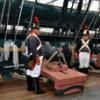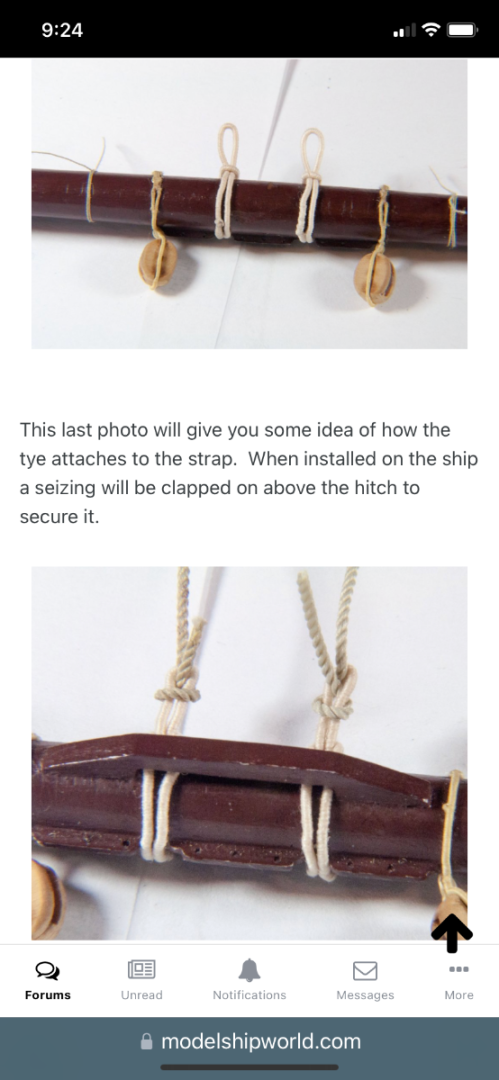-
Posts
1,933 -
Joined
-
Last visited
Content Type
Profiles
Forums
Gallery
Events
Posts posted by popeye2sea
-
-
-
Bill,
Nice story. I'm pleased that you ran with it. The ship is looking great. And the gun crews will be the envy of the fleet!
Regards,
Henry
-
32 minutes ago, allanyed said:
Lees (or me😀) may have this wrong or it may just be a matter of terminology but on page 80 and page 91 of The Masting and Rigging of British Ships of War he describes the larger lower block of the pair, or larger sheave if a fiddle block, as used for the topsail sheet, not a tack. He makes no mention of there being a tack for the topsails.
Allan
You are correct Allan. Topsails have no tack. The sheet holds them confined to the lower yard.
Regards,
Henry
-
Good find. Thanks!
Regards,
Henry
- mtaylor, thibaultron, Canute and 1 other
-
 4
4
-
Envision a scenario whereby the ship is underway and exercising the great guns. Picture this - The 1st Lieutenant orders the guns to be exercised by division. The second LT, who is in charge of the second deck battery, orders the first division, in this case it could be the first four guns on the port side, to prime, load, and fire. He will compare their best time with the other divisions for a bit of competition.
Bottom line. Display them however you choose. Anything can be justified with a good narrative.
Regards,
Henry
- 72Nova, Ian_Grant and Ferrus Manus
-
 3
3
-
BTW, I made a spreadsheet of all of the rigging plan, calling out all of the blocks and fittings needed. It helped me greatly to figure out how the rigging runs and what blocks to put where. I can more easily search the spreadsheet for a particular line than try and follow it through multiple pages of the Heller instruction booklet.
Regards,
Henry
-
Not sure if my rigging plan compares to yours but here is what mine shows for lines leading through the saddle.
Saddle port side top to bottom. duplicate on starboard side except 1011
1011 Fore topmast stay tackle
1018 Spritsail brace
1098 Fore sail bowline
1088 Spritsail clew line
Rack Block ( on gammoning) port side top to bottom
1023 Spritsail yard lift/spritsail topsail sheet
1020 Spritsail topsail brace
1096 Fore topsail bowline
1094 Fore topgallant bowline
1085 Spritsail topsail clew line
There may be additional lines run through there but I would have to do a more complete search of the plan.
Hope that helps
Regards,
Henry
- Hubac's Historian and Bill97
-
 2
2
-
12 minutes ago, Bill97 said:
Top sprit yard installed and rigged. There surprisingly is a lot of rigging to that little yard! Still studying to determine the exact belay points for the halyards for it and the spritsail yard. One instruction I have shows the lines going through the holes in the bowsprit halyard guide then up to the rail. Another instruction has them going directly to the rail or tie off to the gammoning.
Take them through the saddle fairlead. That is it's intended purpose. Other parts of the running rigging for the spritsail and spritsail topsail will go through the rack block on the gammoning.
Regards,
Henry
-
The spritsail yard looks great.
Regards,
Henry
-
"I’ve seen all the drawings and diagrams that show the gun tackle ropes in neat inspection-ready coils, but I wonder what the gun crews really did with their lines. I didn’t glue the coils down all that securely just in case I see something that changes my mind."
When in action, coils like you have, or Flemish coils ( the ones that look like spirals) are a big no-no. When the gun fires the side tackles act as a sort of recoil brake. If the lines are coiled they will kink and jam when the rope starts to run out. One way to avoid this is to flake (or fake) down the rope. You can look this up in the Ashley Book of Knots or other knotting reference. There are videos on you tube that show it, but do not use the modern rope climber method of flaking which, to my sailors eye, just looks like an unusable puddle of rope on the deck. Use the proper nautical method still used today to make up ropes to run freely.
Regards,
Henry
-
2 hours ago, Hubac's Historian said:
Open question: at this scale, does anyone actually rig parrels around the yardarms, or do they merely represent them on the mast? I’m trying to figure out how to do thst with the shrouds in place.
I can't leave them out. And I would like to make them as functional as possible. Finding the appropriate size beads for the parrels is not easy at 1:100 scale.
Henry
-
10 hours ago, Bill97 said:
Henry I continue to have your build bookmarked for quick reference. I find your rigging skill’s fascinating. Now that I have made all my yards I am researching the cleats. As you probably know Heller does not provide them. Either the one for the center of the yard nor the ends of the yard arm. Anderson is not definitive on when they came into use but it seems the SR construction was in the time frame. So like you I intend to add them to the appropriate yards. Here is where I again referred to your build. It appears in your photo that you added the cleat after painting and rigging the yard instead of before. Am I correct? Which yards did you add the cleats too. Looking a little further into your build, I think your parrals are beautiful. Did you need to add an eyebolt at the deck and form a two block tackle to except the falls from the parrals?
The cleats are added to the yard prior to rigging. The straps inside of the cleats are selvagees (a continuous loop of rope) that is passed around the yard within the cleat before one end is inserted through the other to form the strap that takes the halliard tye. The quarter blocks for the topsail sheets are stropped with two eyes that pass around the fore and aft sides of the yard to be joined by a rose lashing atop the yard.
When I get to that point I will add cleats as well to the upper yards. I believe that they are open or horn cleats as opposed to the closed cleat for the courses.
Yes, there will have to be determined an appropriate belaying point for the truss pendant tackle. On my rigging plan there are two eyebolts either side of the fore mast, labelled a1 and a2 that do not appear to be used that I will repurpose for the lower block hooks. On the main there are two eyebolts designated for studdingsail halliards, that I am not using, so I will repurpose them for truss tackles.
BTW, I am still not certain that the parrel falls for the upper yards came all the way to the deck. I have read references that they terminate in the tops.
Regards,
Henry
P.S. I am impressed by advances you have made in correct terminology usage in the short time since this build log started.
-
Pete,
When not ready for battle the cannons would have been secured by lashing to the bulwarks of the ship. The free ends of the side tackles would be frapped (wrapped) around the fall.
Regards,
Henry
- mtaylor and piratepete007
-
 2
2
-
-
Looks like you've got all the stays. Great job so far.
Regards,
Henry
-
John,
Your ability to bring the story to life is outstanding as is your ability to bring the frieze work to life. I am in awe of your decal work. The ship looks amazing.
All of these other SR build logs have got me really wanting to get back to my build.
Regards,
Henry
P.S. Dead reckoning is actually Ded. Reckoning and is a shortened spelling of deduced reckoning which is continuing the plotting of a course line forward based on the information obtained from your last good position fix. The ded reckoning plot line is marked at set time intervals to estimate what your deduced position will be. When you actually get to that time point and take a position fix you can then calculate based on the difference between that fix and the deduced point what your set and drift are. In other words how much you are being blown off course by wind and current. Then you can correct your course accordingly.
So endeth the lesson on navigation.
Regards,
-
Perhaps yes, handrails for the upper decks, for instance leading up to the quarter deck and poop. But, I wonder if they were fitted for going below. A single grab rail in an overhead beam would suffice for many applications.
Regards,
Henry
- tmj, Keith Black and mtaylor
-
 3
3
-
The lower yard should be hung right at the level of the catharpins. In fact, that is one of the functions of the catharpins. To swifter in the shrouds to allow the yard to be able to brace up to its maximum extent.
Also, the foremost shroud would not be placed so that it lies before the mast. Not something you can correct for the Heller kit.
Regards,
Henry
-
-
Marines were definitely in a separate administrative and operational organization. They only received orders and disciplinary actions from the Marine officers. However the Marine officers answered to the Captain of the ship who was in ultimate charge of everything that went on in his ship. In the Royal Navy Marines could also be called upon to man the cannons during battle.
Regards,
Henry
- Canute, thibaultron and mtaylor
-
 3
3
-
That was pretty much it. Standing guard or drilling. Marines did not stand watches like the sailors. Maintaining their uniforms and weapons also occupied some of their time. Marines uniforms had to look in top condition all the time. Polishing brass and whitening leathers takes a good amount of time. Trust me, I have to do it frequently. And I use modern cleaners and whiteners.
My profile pic is me in 1812 US Marine uniform.
Regards,
Henry
- mtaylor, Canute and thibaultron
-
 3
3
-
-
My wife and I spent 3 days in Edinburgh and then rented a car for a grand tour of the highlands. Culross, Stirling, Loch Lomond, Loch Fyne, Inverary, Kilmartin Glen, Fort William, Glen Finnan, Isle of Skye, Inverness, Culloden, Loch Ness, Aberdeen. Then back to Edinburgh on our anniversary. Returned home yesterday.
Regards,
- Baker, Ian_Grant and Hubac's Historian
-
 2
2
-
 1
1
-
Sorry I have not had a chance to reply over the last two weeks. I was on vacation in Scotland.
I agree with Marc and Ian the topmast trestle and cross trees are too long and should be trimmed back. Also the rear hole should fit closely around the topmast head while the forward hole should admit the square lower section of the topgallant mast. For those reasons I will probably fabricate my own cross trees.
Also I have never been a fan of those round sections of the mast that are supposed to represent the cheeks and hounds. I think those are another Hellerism.
Regards,
Henry





Le Soleil Royal by Bill97 - FINISHED - Heller - 1/100
in - Kit build logs for subjects built from 1501 - 1750
Posted
For ships of HMS Victory vintage, there is no expectation of lowering the course yards on a regular basis, hence no need for parrals. There remains a need to truss the yard in towards the mast so truss tackles ( or tackle truss?) are employed.
Regards,
Henry